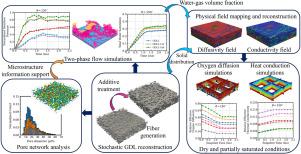Pore-scale numerical investigation of water–gas flow and heat transport in gas diffusion layers with varying fiber/additive content and hydrophobicity
IF 5.8
2区 工程技术
Q1 ENGINEERING, MECHANICAL
International Journal of Heat and Mass Transfer
Pub Date : 2025-09-29
DOI:10.1016/j.ijheatmasstransfer.2025.127859
引用次数: 0
Abstract
Additives such as binders and hydrophobic agents are commonly introduced into the fibrous Gas Diffusion Layer (GDL) of proton exchange membrane fuel cells to enhance mechanical strength and facilitate water management. However, the effect of additive/fiber content and surface wettability on water removal, oxygen diffusion, and heat conduction remains insufficiently understood. In this work, we develop a stochastic GDL reconstruction framework with systematically varied fiber and additive content. The reconstructed structures are analyzed through pore–throat network extraction, interface-resolved two-phase flow simulations, as well as oxygen diffusion and heat conduction simulations under dry and partially saturated conditions. The variation in surface wettability caused by the coating of hydrophobic additives is simulated by the contact angle. The results reveal that increased fiber content significantly restricts pore space, thereby weakening oxygen diffusivity and increasing breakthrough pressure, while having a limited impact on stabilized water saturation and thermal conductivity. Additives, particularly at high loadings, reduce pore connectivity and gas transport, though enhanced hydrophobicity partially mitigates these effects. Oxygen diffusivity is found to be particularly sensitive to changes in effective pore space caused by additive inclusion and water occupation. These findings present a comprehensive quantitative perspective on how additive design modulates GDL transport properties and provide a simulation-based framework for optimizing fuel cell GDL microstructure.

不同纤维/添加剂含量和疏水性的气体扩散层中水气流动和热传递的孔隙尺度数值研究
在质子交换膜燃料电池的纤维气体扩散层(GDL)中通常引入粘合剂和疏水剂等添加剂,以提高其机械强度和便于水管理。然而,添加剂/纤维含量和表面润湿性对除水、氧扩散和热传导的影响仍未得到充分的了解。在这项工作中,我们开发了一个随机的GDL重建框架,系统地改变纤维和添加剂的含量。通过孔喉网络提取、界面解析两相流模拟以及干燥和部分饱和条件下的氧扩散和热传导模拟对重构结构进行了分析。用接触角模拟了疏水添加剂涂层引起的表面润湿性变化。结果表明,纤维含量的增加明显限制了孔隙空间,从而削弱了氧扩散率,增加了突破压力,而对稳定含水饱和度和导热系数的影响有限。添加剂,特别是在高负载时,会降低孔隙连通性和气体输运,尽管增强的疏水性部分减轻了这些影响。氧扩散率对添加剂包裹体和水占据引起的有效孔隙空间变化特别敏感。这些发现为增材设计如何调节GDL输运特性提供了一个全面的定量视角,并为优化燃料电池GDL微观结构提供了一个基于模拟的框架。
本文章由计算机程序翻译,如有差异,请以英文原文为准。
求助全文
约1分钟内获得全文
求助全文
来源期刊
CiteScore
10.30
自引率
13.50%
发文量
1319
审稿时长
41 days
期刊介绍:
International Journal of Heat and Mass Transfer is the vehicle for the exchange of basic ideas in heat and mass transfer between research workers and engineers throughout the world. It focuses on both analytical and experimental research, with an emphasis on contributions which increase the basic understanding of transfer processes and their application to engineering problems.
Topics include:
-New methods of measuring and/or correlating transport-property data
-Energy engineering
-Environmental applications of heat and/or mass transfer

 求助内容:
求助内容: 应助结果提醒方式:
应助结果提醒方式:


